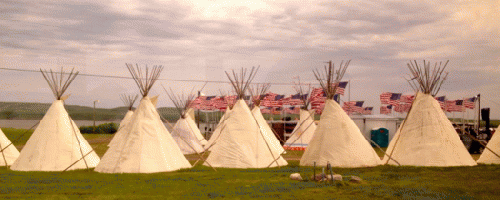The full June moon known to First Nation peoples as the Strawberry Moon crept over the trees in the east as the sun set over the Sitting Bull memorial at the Standing Rock Indian Reservation. President Obama was scheduled to meet with the tribal council the following day in nearby Cannon Ball, but other than a few tribal flags along Highway 24, things were quiet. Buffalo, horses and cattle grazed peacefully in the rolling green valleys. We had almost completed a 1400 mile trip that began as a visual tour of the proposed Enbridge Sandpiper Pipeline that had raised more questions than it answered.
A representative from Honor the Earth was along for the ride and we sometimes found ourselves sparring over human and environmental impacts of the pipeline project. Were trains better than pipelines, or are pipeline better than trains?
We agreed that oil exploration and extraction in the Bakken Formation was taking a mighty toll on indigenous and white communities alike. The stark difference was that white residents of North Dakota seemed to be rolling over to the inevitability of big oil and its impact upon the social, political and environmental landscapes of their communities. Elders in the native communities spoke of a "war" that they were loosing in the effort to preserve a way of life that is intimately connected to the sacred. This includes the ability to see the night sky without having the stars dimmed by gas flaring and the right to protect sacred grounds from development. Elder Marilyn Hudson, a Hidatsa from Fort Berthold, put it this way.
"There has been an undefined battle and we woke up one day and realized we had lost it," Hudson said over lunch at the Wrangler Cafe in Parshall. "The rate of oil development has been overwhelming and we realized something was encroaching, but could not define what it was. What we did know was that no one from the Federal level on down to our tribal council has the best interests of the tribal members in mind."
Hudson decried the disconnect between tribal members and the tribal government. Information about something as basic as the number of pipelines running underground through reservation land is difficult to find. Hudson is still searching for an inclusive map.
The same disconnect was evident in white society. After visiting county courthouses from Grand Forks to Minot, it became clear that officials at the local level had no idea of the location of the proposed Sandpiper route. This included editors at county newspapers, county assessors, and planning commissions. There were no detailed maps on file in government offices and Enbridge would not publish GIS coordinates, citing the Patriot Act and national security regarding energy infrastructure as the reason.
We spoke with locals in remote cafes as trains hauling outdated and unsafe DOT 111 tanker cars lumbered and clanked within 30 yards of our indoor booth. We heard stories of land for sale for man camps, women afraid to go to the store at night, robberies, and tree houses coveted as potential housing for oil field roustabouts. There were unsubstantiated rumors of a sex trade and substantiated facts of prostitution and uncontrolled drug use. Hookers and oil workers turned hotels in Minot into man-camps. Many rooms were booked a year in advance and checking in required a 20 minute wait at one major chain while a woman argued for her discount from an oil company.
But we were not equipped, nor did we have the time to investigate the impact on social mores in North Dakota. An investigation of that depth would take months if not years of living in the affected communities. Still, it was impossible to ignore the blatant destruction of once-sleepy and wholesome Midwestern communities. Even if you were to neglect the social impacts, the filth was unavoidable. Cigarette buts, diapers, liquor bottles, mud and gravel littered once clean parking lots and ditches. Potholes were everywhere, and we were hundreds of miles from the main oil patch near Fort Berthold.
A serene way of life seemed to have vanished in an instant.
Marilyn Hudson spoke passionately of the native community. The white community seemed almost indifferent to the disintegration of their society. But white society was relatively new to the landscape. Did this explain the callous disregard we witnessed? Or were they simply disengaged? Too caught up in trying to survive and navigate the great distances of the northern plains as they farmed and went about making a living or enjoying what remained of their golden years. With a population density of less than ten people per square mile, was white society disconnected from itself?
"I had better keep an eye out. That pipeline might run right through my house." (Elderly waitress joking with us in a rural cafe)
First Nation people have been here for thousands of years and still maintain community on reservation lands.
The truth is opaque, if it is discernible at all.
The maps of the North Dakota pipelines are confusing color-coded slashes and dots of red, blue, and green. On most of them there are no overlays of roads, infrastructure and topography. Our original goal was to find the route of the proposed Enbridge Sandpiper Pipeline as it crosses the North Dakota/ Minnesota border south of Grand Forks and follow it west to its terminus in Beaver Lodge, Dry Fork Township, Williams County. Enbridge had the North Dakota counties and townships published in the Public Land Survey System (PLSS) format, but doing ground truthing on the proposed pipeline turned out to be another story. Actually it became the story, and Enbridge sent us more detailed maps while we were on the road.
(Note: You can view every article as one long page if you sign up as an Advocate Member, or higher).






